Analyzing Literacy, Numeracy, Technology and Media in Early Education
VerifiedAdded on 2022/11/09
|10
|2789
|2
Essay
AI Summary
This essay critically analyzes the evolving landscape of early childhood education, focusing on the dynamic interplay between literacy, numeracy, technology, and media. It explores the concept of multiple literacies, encompassing visual, textual, digital, and technological literacies, and examines how these modalities are utilized in contemporary classrooms. The essay delves into the ongoing debates surrounding various approaches to literacy and numeracy learning, highlighting the influence of technology and media on young children's development. It also examines the pivotal role of early childhood educators in supporting children and their families within an increasingly digital social world, addressing concerns about internet usage, cyber safety, and the balance between screen time and other learning experiences. Furthermore, the essay discusses the integration of ICT in curriculum, the importance of digital citizenship, and the need for educators to adapt to the changing needs of young learners, emphasizing the importance of creating a sustainable education system and promoting community-based activities. The essay also touches on the role of parents in supporting children's learning and the need for teachers to educate them about the benefits of technology.
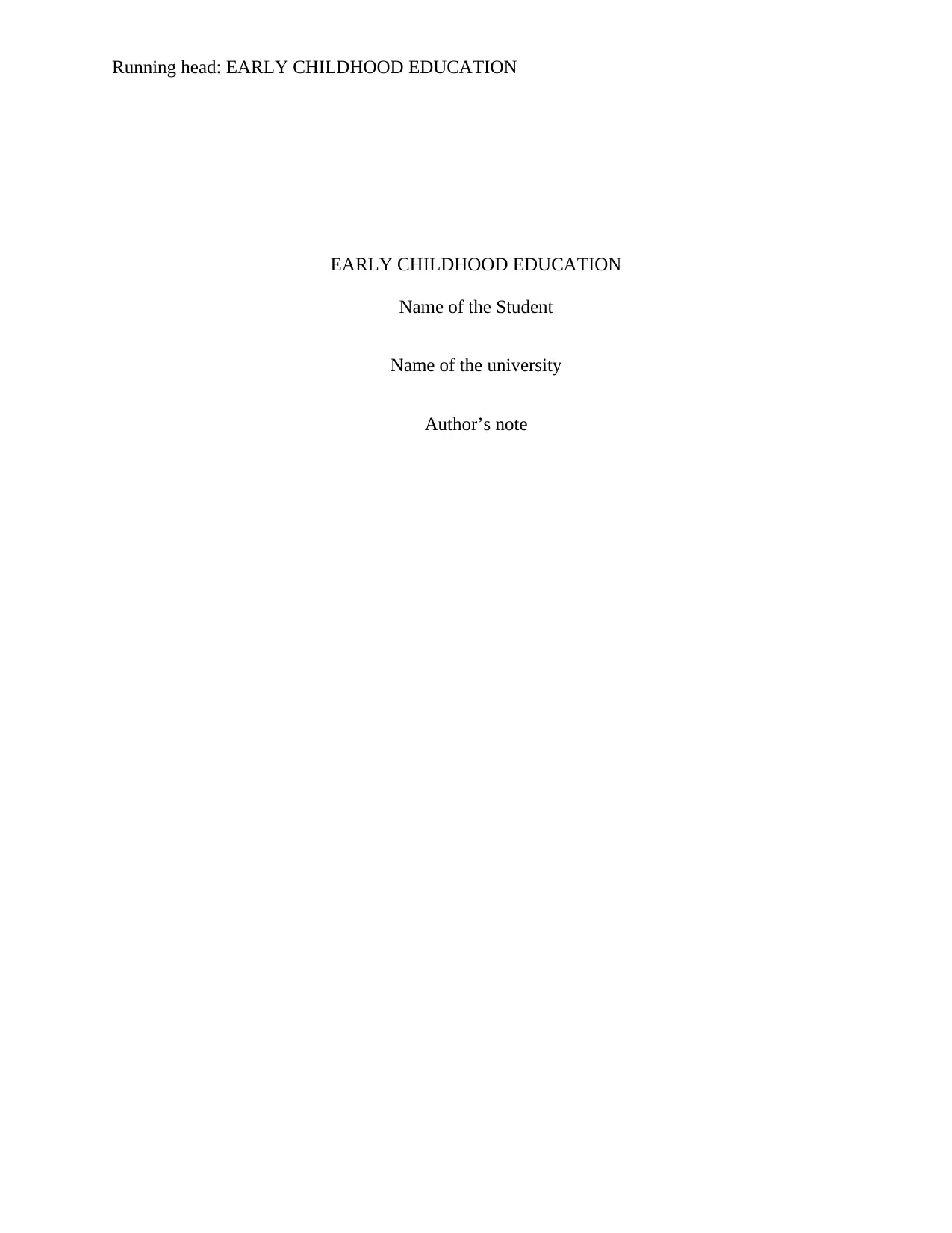
Running head: EARLY CHILDHOOD EDUCATION
EARLY CHILDHOOD EDUCATION
Name of the Student
Name of the university
Author’s note
EARLY CHILDHOOD EDUCATION
Name of the Student
Name of the university
Author’s note
Paraphrase This Document
Need a fresh take? Get an instant paraphrase of this document with our AI Paraphraser
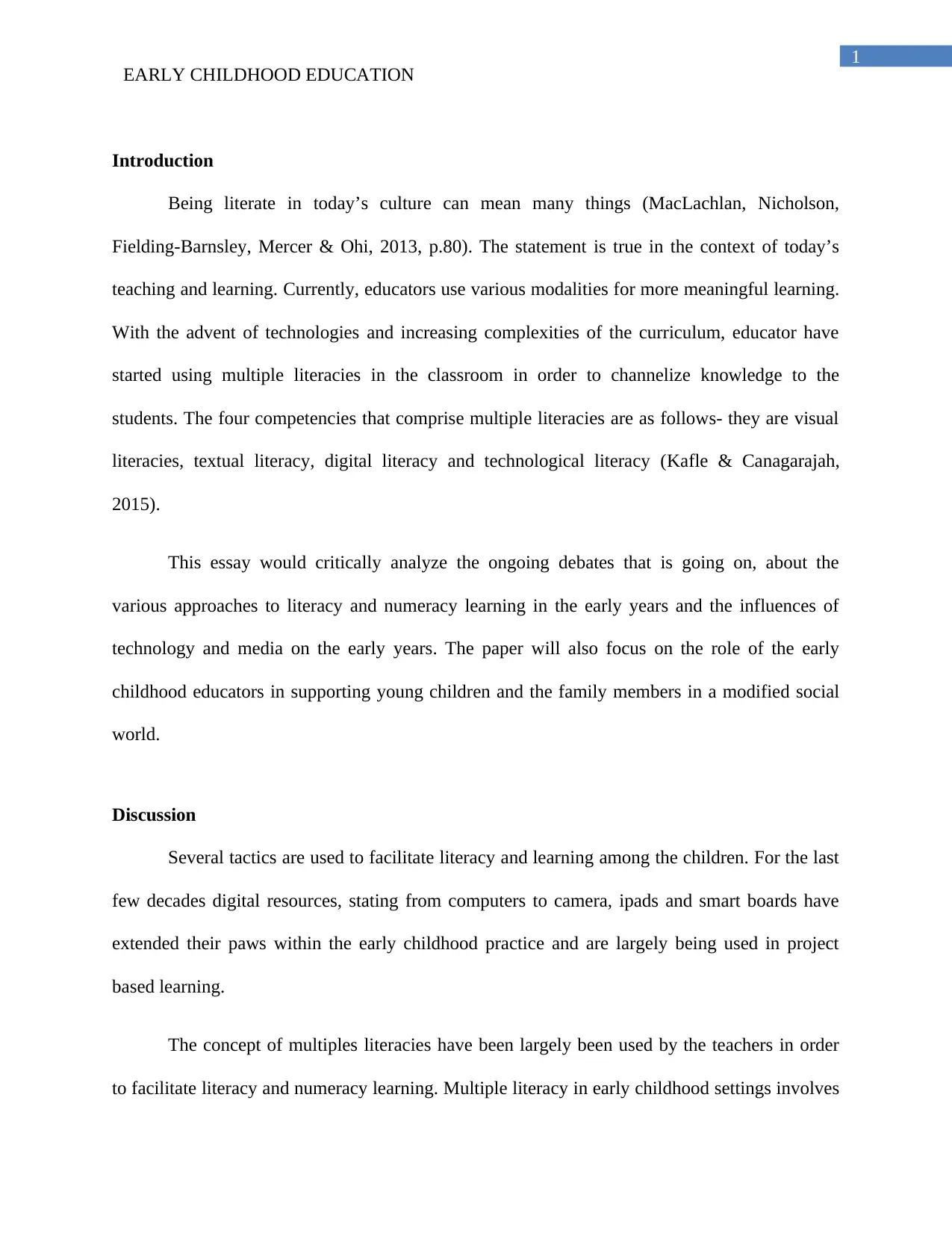
1
EARLY CHILDHOOD EDUCATION
Introduction
Being literate in today’s culture can mean many things (MacLachlan, Nicholson,
Fielding-Barnsley, Mercer & Ohi, 2013, p.80). The statement is true in the context of today’s
teaching and learning. Currently, educators use various modalities for more meaningful learning.
With the advent of technologies and increasing complexities of the curriculum, educator have
started using multiple literacies in the classroom in order to channelize knowledge to the
students. The four competencies that comprise multiple literacies are as follows- they are visual
literacies, textual literacy, digital literacy and technological literacy (Kafle & Canagarajah,
2015).
This essay would critically analyze the ongoing debates that is going on, about the
various approaches to literacy and numeracy learning in the early years and the influences of
technology and media on the early years. The paper will also focus on the role of the early
childhood educators in supporting young children and the family members in a modified social
world.
Discussion
Several tactics are used to facilitate literacy and learning among the children. For the last
few decades digital resources, stating from computers to camera, ipads and smart boards have
extended their paws within the early childhood practice and are largely being used in project
based learning.
The concept of multiples literacies have been largely been used by the teachers in order
to facilitate literacy and numeracy learning. Multiple literacy in early childhood settings involves
EARLY CHILDHOOD EDUCATION
Introduction
Being literate in today’s culture can mean many things (MacLachlan, Nicholson,
Fielding-Barnsley, Mercer & Ohi, 2013, p.80). The statement is true in the context of today’s
teaching and learning. Currently, educators use various modalities for more meaningful learning.
With the advent of technologies and increasing complexities of the curriculum, educator have
started using multiple literacies in the classroom in order to channelize knowledge to the
students. The four competencies that comprise multiple literacies are as follows- they are visual
literacies, textual literacy, digital literacy and technological literacy (Kafle & Canagarajah,
2015).
This essay would critically analyze the ongoing debates that is going on, about the
various approaches to literacy and numeracy learning in the early years and the influences of
technology and media on the early years. The paper will also focus on the role of the early
childhood educators in supporting young children and the family members in a modified social
world.
Discussion
Several tactics are used to facilitate literacy and learning among the children. For the last
few decades digital resources, stating from computers to camera, ipads and smart boards have
extended their paws within the early childhood practice and are largely being used in project
based learning.
The concept of multiples literacies have been largely been used by the teachers in order
to facilitate literacy and numeracy learning. Multiple literacy in early childhood settings involves
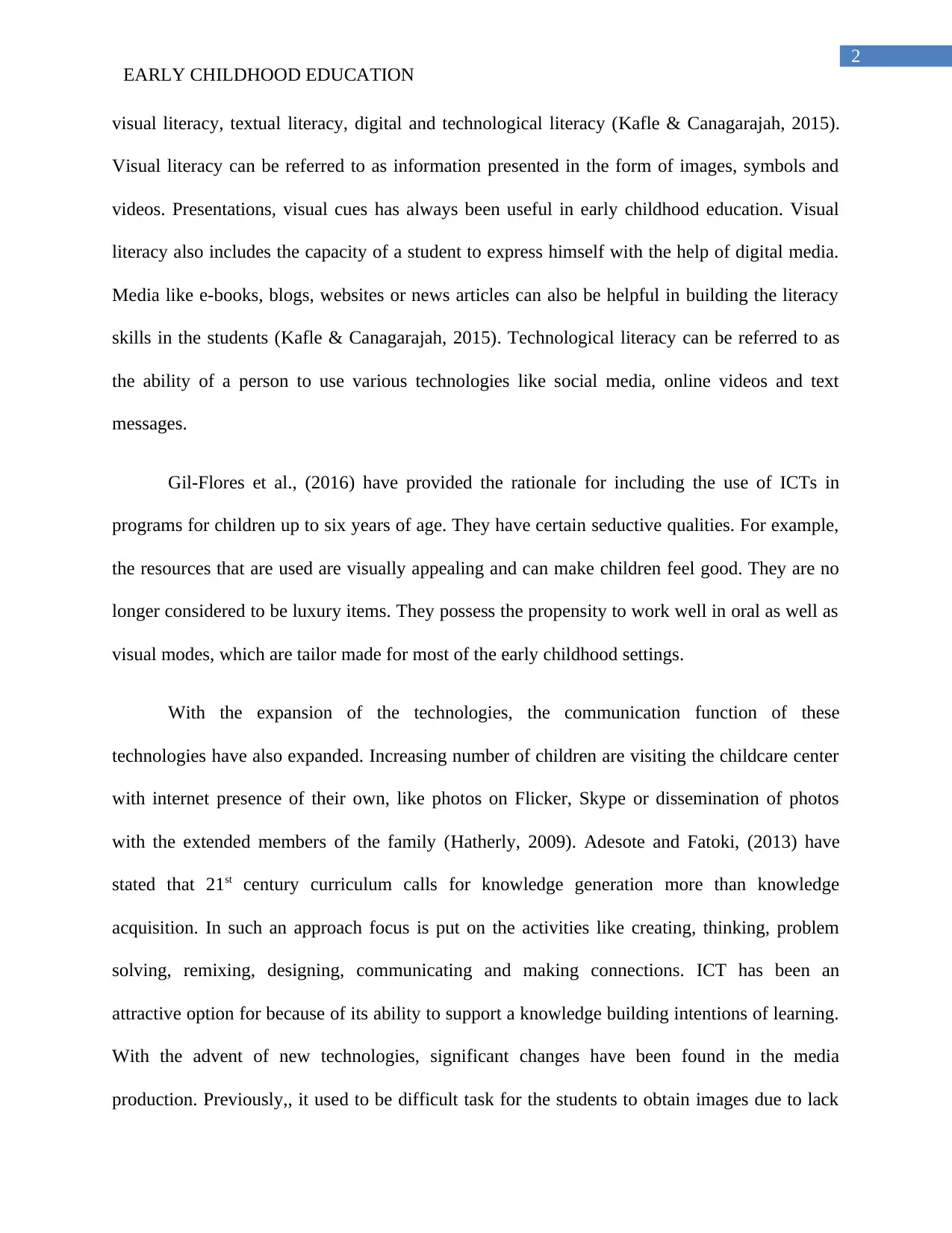
2
EARLY CHILDHOOD EDUCATION
visual literacy, textual literacy, digital and technological literacy (Kafle & Canagarajah, 2015).
Visual literacy can be referred to as information presented in the form of images, symbols and
videos. Presentations, visual cues has always been useful in early childhood education. Visual
literacy also includes the capacity of a student to express himself with the help of digital media.
Media like e-books, blogs, websites or news articles can also be helpful in building the literacy
skills in the students (Kafle & Canagarajah, 2015). Technological literacy can be referred to as
the ability of a person to use various technologies like social media, online videos and text
messages.
Gil-Flores et al., (2016) have provided the rationale for including the use of ICTs in
programs for children up to six years of age. They have certain seductive qualities. For example,
the resources that are used are visually appealing and can make children feel good. They are no
longer considered to be luxury items. They possess the propensity to work well in oral as well as
visual modes, which are tailor made for most of the early childhood settings.
With the expansion of the technologies, the communication function of these
technologies have also expanded. Increasing number of children are visiting the childcare center
with internet presence of their own, like photos on Flicker, Skype or dissemination of photos
with the extended members of the family (Hatherly, 2009). Adesote and Fatoki, (2013) have
stated that 21st century curriculum calls for knowledge generation more than knowledge
acquisition. In such an approach focus is put on the activities like creating, thinking, problem
solving, remixing, designing, communicating and making connections. ICT has been an
attractive option for because of its ability to support a knowledge building intentions of learning.
With the advent of new technologies, significant changes have been found in the media
production. Previously,, it used to be difficult task for the students to obtain images due to lack
EARLY CHILDHOOD EDUCATION
visual literacy, textual literacy, digital and technological literacy (Kafle & Canagarajah, 2015).
Visual literacy can be referred to as information presented in the form of images, symbols and
videos. Presentations, visual cues has always been useful in early childhood education. Visual
literacy also includes the capacity of a student to express himself with the help of digital media.
Media like e-books, blogs, websites or news articles can also be helpful in building the literacy
skills in the students (Kafle & Canagarajah, 2015). Technological literacy can be referred to as
the ability of a person to use various technologies like social media, online videos and text
messages.
Gil-Flores et al., (2016) have provided the rationale for including the use of ICTs in
programs for children up to six years of age. They have certain seductive qualities. For example,
the resources that are used are visually appealing and can make children feel good. They are no
longer considered to be luxury items. They possess the propensity to work well in oral as well as
visual modes, which are tailor made for most of the early childhood settings.
With the expansion of the technologies, the communication function of these
technologies have also expanded. Increasing number of children are visiting the childcare center
with internet presence of their own, like photos on Flicker, Skype or dissemination of photos
with the extended members of the family (Hatherly, 2009). Adesote and Fatoki, (2013) have
stated that 21st century curriculum calls for knowledge generation more than knowledge
acquisition. In such an approach focus is put on the activities like creating, thinking, problem
solving, remixing, designing, communicating and making connections. ICT has been an
attractive option for because of its ability to support a knowledge building intentions of learning.
With the advent of new technologies, significant changes have been found in the media
production. Previously,, it used to be difficult task for the students to obtain images due to lack
⊘ This is a preview!⊘
Do you want full access?
Subscribe today to unlock all pages.

Trusted by 1+ million students worldwide
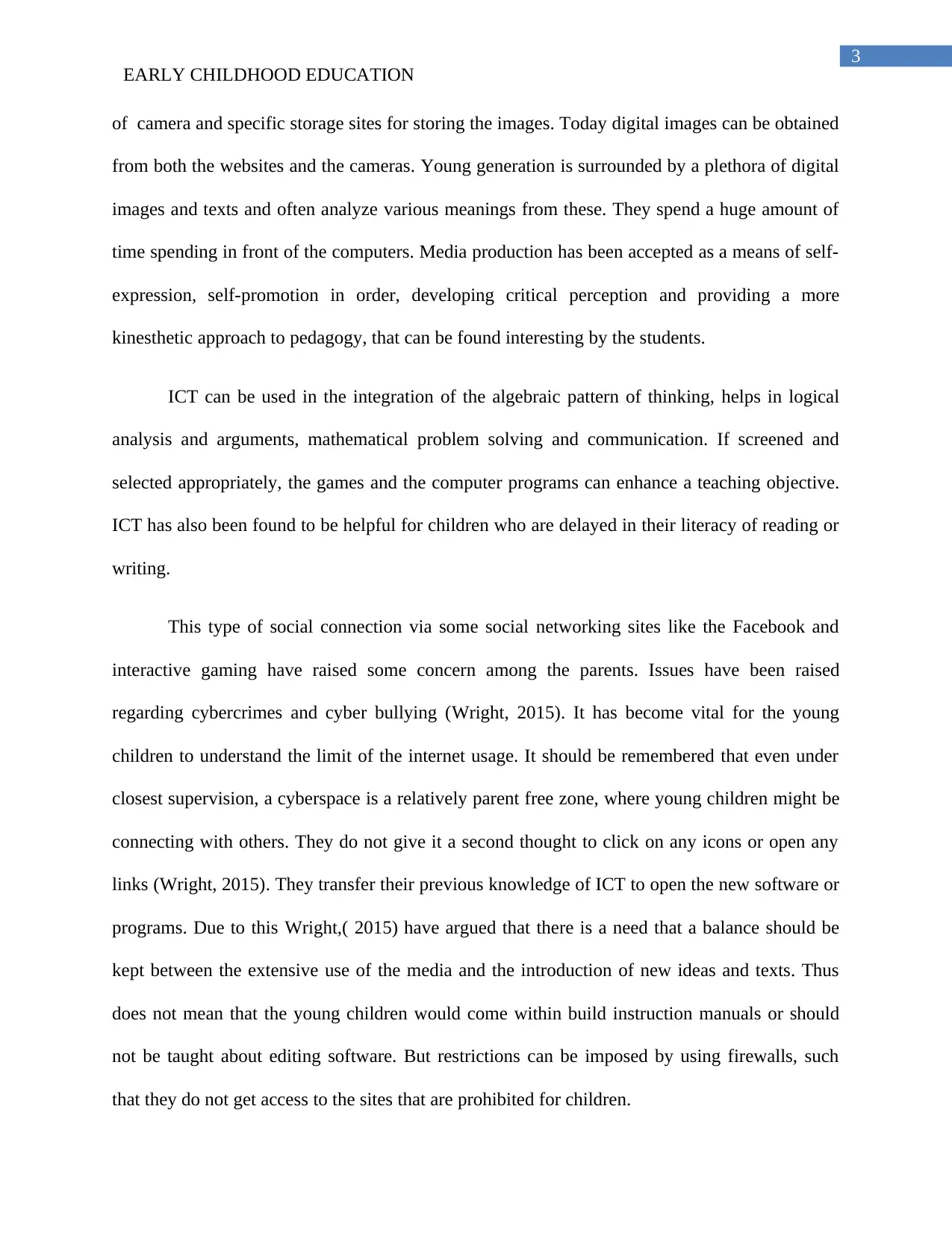
3
EARLY CHILDHOOD EDUCATION
of camera and specific storage sites for storing the images. Today digital images can be obtained
from both the websites and the cameras. Young generation is surrounded by a plethora of digital
images and texts and often analyze various meanings from these. They spend a huge amount of
time spending in front of the computers. Media production has been accepted as a means of self-
expression, self-promotion in order, developing critical perception and providing a more
kinesthetic approach to pedagogy, that can be found interesting by the students.
ICT can be used in the integration of the algebraic pattern of thinking, helps in logical
analysis and arguments, mathematical problem solving and communication. If screened and
selected appropriately, the games and the computer programs can enhance a teaching objective.
ICT has also been found to be helpful for children who are delayed in their literacy of reading or
writing.
This type of social connection via some social networking sites like the Facebook and
interactive gaming have raised some concern among the parents. Issues have been raised
regarding cybercrimes and cyber bullying (Wright, 2015). It has become vital for the young
children to understand the limit of the internet usage. It should be remembered that even under
closest supervision, a cyberspace is a relatively parent free zone, where young children might be
connecting with others. They do not give it a second thought to click on any icons or open any
links (Wright, 2015). They transfer their previous knowledge of ICT to open the new software or
programs. Due to this Wright,( 2015) have argued that there is a need that a balance should be
kept between the extensive use of the media and the introduction of new ideas and texts. Thus
does not mean that the young children would come within build instruction manuals or should
not be taught about editing software. But restrictions can be imposed by using firewalls, such
that they do not get access to the sites that are prohibited for children.
EARLY CHILDHOOD EDUCATION
of camera and specific storage sites for storing the images. Today digital images can be obtained
from both the websites and the cameras. Young generation is surrounded by a plethora of digital
images and texts and often analyze various meanings from these. They spend a huge amount of
time spending in front of the computers. Media production has been accepted as a means of self-
expression, self-promotion in order, developing critical perception and providing a more
kinesthetic approach to pedagogy, that can be found interesting by the students.
ICT can be used in the integration of the algebraic pattern of thinking, helps in logical
analysis and arguments, mathematical problem solving and communication. If screened and
selected appropriately, the games and the computer programs can enhance a teaching objective.
ICT has also been found to be helpful for children who are delayed in their literacy of reading or
writing.
This type of social connection via some social networking sites like the Facebook and
interactive gaming have raised some concern among the parents. Issues have been raised
regarding cybercrimes and cyber bullying (Wright, 2015). It has become vital for the young
children to understand the limit of the internet usage. It should be remembered that even under
closest supervision, a cyberspace is a relatively parent free zone, where young children might be
connecting with others. They do not give it a second thought to click on any icons or open any
links (Wright, 2015). They transfer their previous knowledge of ICT to open the new software or
programs. Due to this Wright,( 2015) have argued that there is a need that a balance should be
kept between the extensive use of the media and the introduction of new ideas and texts. Thus
does not mean that the young children would come within build instruction manuals or should
not be taught about editing software. But restrictions can be imposed by using firewalls, such
that they do not get access to the sites that are prohibited for children.
Paraphrase This Document
Need a fresh take? Get an instant paraphrase of this document with our AI Paraphraser
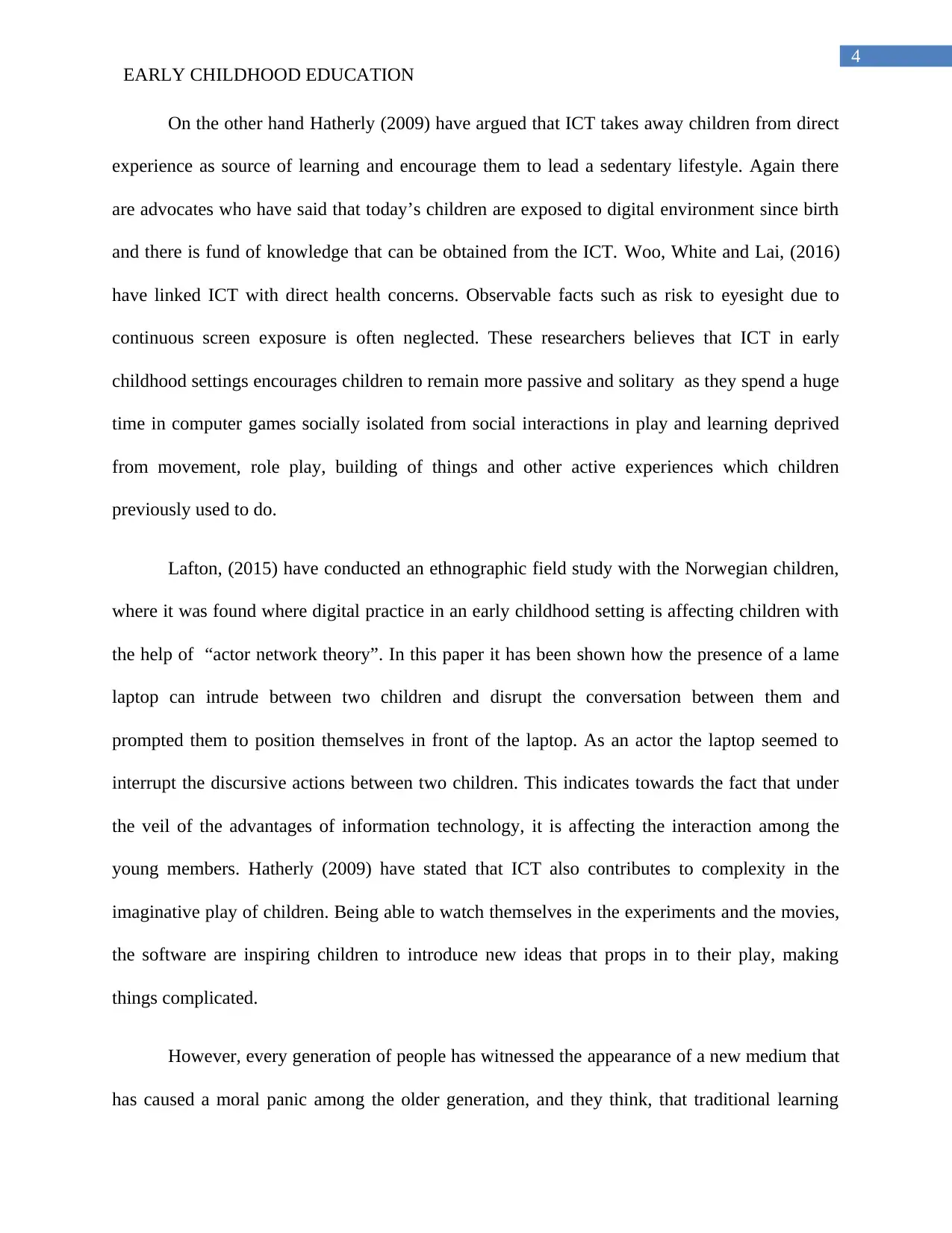
4
EARLY CHILDHOOD EDUCATION
On the other hand Hatherly (2009) have argued that ICT takes away children from direct
experience as source of learning and encourage them to lead a sedentary lifestyle. Again there
are advocates who have said that today’s children are exposed to digital environment since birth
and there is fund of knowledge that can be obtained from the ICT. Woo, White and Lai, (2016)
have linked ICT with direct health concerns. Observable facts such as risk to eyesight due to
continuous screen exposure is often neglected. These researchers believes that ICT in early
childhood settings encourages children to remain more passive and solitary as they spend a huge
time in computer games socially isolated from social interactions in play and learning deprived
from movement, role play, building of things and other active experiences which children
previously used to do.
Lafton, (2015) have conducted an ethnographic field study with the Norwegian children,
where it was found where digital practice in an early childhood setting is affecting children with
the help of “actor network theory”. In this paper it has been shown how the presence of a lame
laptop can intrude between two children and disrupt the conversation between them and
prompted them to position themselves in front of the laptop. As an actor the laptop seemed to
interrupt the discursive actions between two children. This indicates towards the fact that under
the veil of the advantages of information technology, it is affecting the interaction among the
young members. Hatherly (2009) have stated that ICT also contributes to complexity in the
imaginative play of children. Being able to watch themselves in the experiments and the movies,
the software are inspiring children to introduce new ideas that props in to their play, making
things complicated.
However, every generation of people has witnessed the appearance of a new medium that
has caused a moral panic among the older generation, and they think, that traditional learning
EARLY CHILDHOOD EDUCATION
On the other hand Hatherly (2009) have argued that ICT takes away children from direct
experience as source of learning and encourage them to lead a sedentary lifestyle. Again there
are advocates who have said that today’s children are exposed to digital environment since birth
and there is fund of knowledge that can be obtained from the ICT. Woo, White and Lai, (2016)
have linked ICT with direct health concerns. Observable facts such as risk to eyesight due to
continuous screen exposure is often neglected. These researchers believes that ICT in early
childhood settings encourages children to remain more passive and solitary as they spend a huge
time in computer games socially isolated from social interactions in play and learning deprived
from movement, role play, building of things and other active experiences which children
previously used to do.
Lafton, (2015) have conducted an ethnographic field study with the Norwegian children,
where it was found where digital practice in an early childhood setting is affecting children with
the help of “actor network theory”. In this paper it has been shown how the presence of a lame
laptop can intrude between two children and disrupt the conversation between them and
prompted them to position themselves in front of the laptop. As an actor the laptop seemed to
interrupt the discursive actions between two children. This indicates towards the fact that under
the veil of the advantages of information technology, it is affecting the interaction among the
young members. Hatherly (2009) have stated that ICT also contributes to complexity in the
imaginative play of children. Being able to watch themselves in the experiments and the movies,
the software are inspiring children to introduce new ideas that props in to their play, making
things complicated.
However, every generation of people has witnessed the appearance of a new medium that
has caused a moral panic among the older generation, and they think, that traditional learning
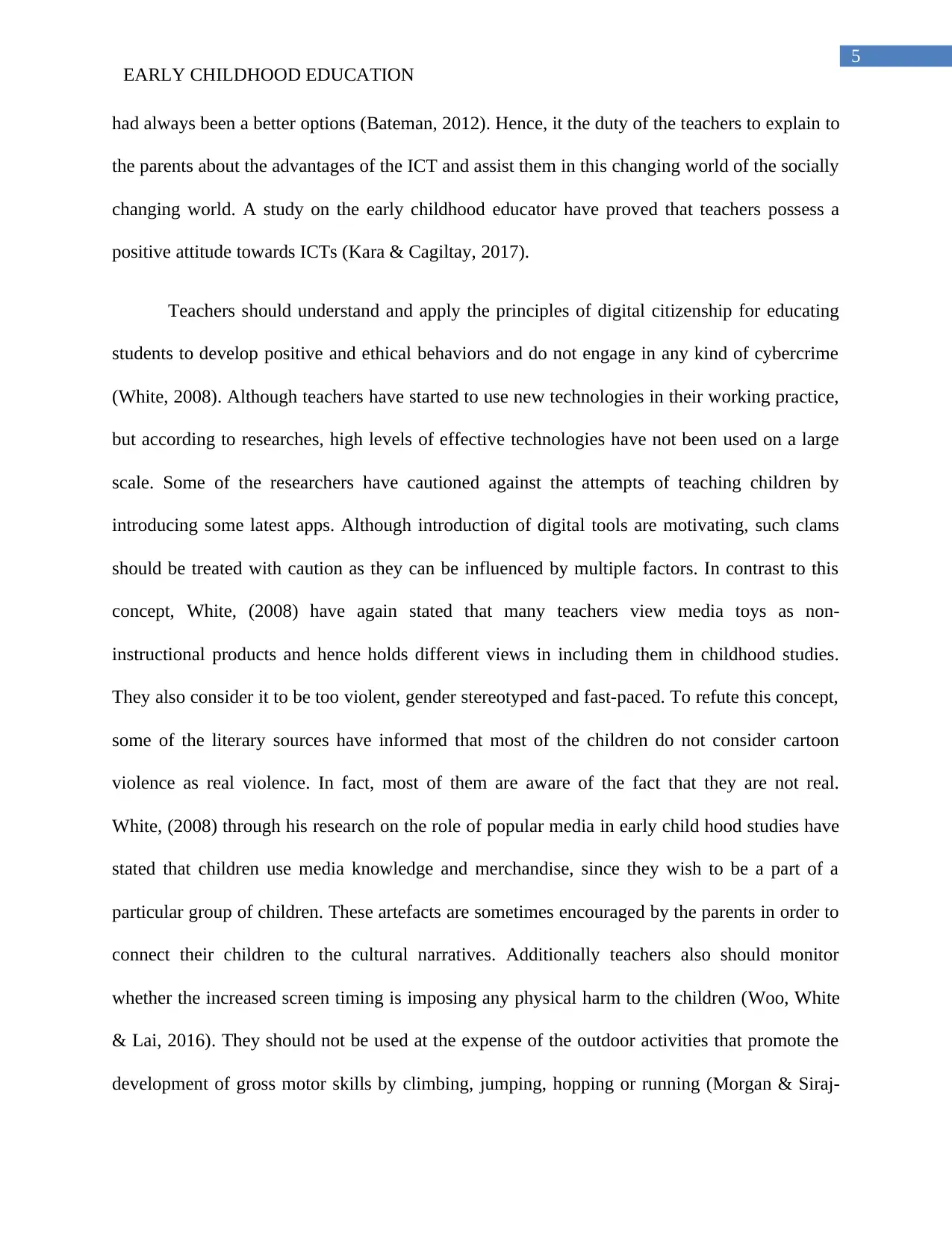
5
EARLY CHILDHOOD EDUCATION
had always been a better options (Bateman, 2012). Hence, it the duty of the teachers to explain to
the parents about the advantages of the ICT and assist them in this changing world of the socially
changing world. A study on the early childhood educator have proved that teachers possess a
positive attitude towards ICTs (Kara & Cagiltay, 2017).
Teachers should understand and apply the principles of digital citizenship for educating
students to develop positive and ethical behaviors and do not engage in any kind of cybercrime
(White, 2008). Although teachers have started to use new technologies in their working practice,
but according to researches, high levels of effective technologies have not been used on a large
scale. Some of the researchers have cautioned against the attempts of teaching children by
introducing some latest apps. Although introduction of digital tools are motivating, such clams
should be treated with caution as they can be influenced by multiple factors. In contrast to this
concept, White, (2008) have again stated that many teachers view media toys as non-
instructional products and hence holds different views in including them in childhood studies.
They also consider it to be too violent, gender stereotyped and fast-paced. To refute this concept,
some of the literary sources have informed that most of the children do not consider cartoon
violence as real violence. In fact, most of them are aware of the fact that they are not real.
White, (2008) through his research on the role of popular media in early child hood studies have
stated that children use media knowledge and merchandise, since they wish to be a part of a
particular group of children. These artefacts are sometimes encouraged by the parents in order to
connect their children to the cultural narratives. Additionally teachers also should monitor
whether the increased screen timing is imposing any physical harm to the children (Woo, White
& Lai, 2016). They should not be used at the expense of the outdoor activities that promote the
development of gross motor skills by climbing, jumping, hopping or running (Morgan & Siraj-
EARLY CHILDHOOD EDUCATION
had always been a better options (Bateman, 2012). Hence, it the duty of the teachers to explain to
the parents about the advantages of the ICT and assist them in this changing world of the socially
changing world. A study on the early childhood educator have proved that teachers possess a
positive attitude towards ICTs (Kara & Cagiltay, 2017).
Teachers should understand and apply the principles of digital citizenship for educating
students to develop positive and ethical behaviors and do not engage in any kind of cybercrime
(White, 2008). Although teachers have started to use new technologies in their working practice,
but according to researches, high levels of effective technologies have not been used on a large
scale. Some of the researchers have cautioned against the attempts of teaching children by
introducing some latest apps. Although introduction of digital tools are motivating, such clams
should be treated with caution as they can be influenced by multiple factors. In contrast to this
concept, White, (2008) have again stated that many teachers view media toys as non-
instructional products and hence holds different views in including them in childhood studies.
They also consider it to be too violent, gender stereotyped and fast-paced. To refute this concept,
some of the literary sources have informed that most of the children do not consider cartoon
violence as real violence. In fact, most of them are aware of the fact that they are not real.
White, (2008) through his research on the role of popular media in early child hood studies have
stated that children use media knowledge and merchandise, since they wish to be a part of a
particular group of children. These artefacts are sometimes encouraged by the parents in order to
connect their children to the cultural narratives. Additionally teachers also should monitor
whether the increased screen timing is imposing any physical harm to the children (Woo, White
& Lai, 2016). They should not be used at the expense of the outdoor activities that promote the
development of gross motor skills by climbing, jumping, hopping or running (Morgan & Siraj-
⊘ This is a preview!⊘
Do you want full access?
Subscribe today to unlock all pages.

Trusted by 1+ million students worldwide
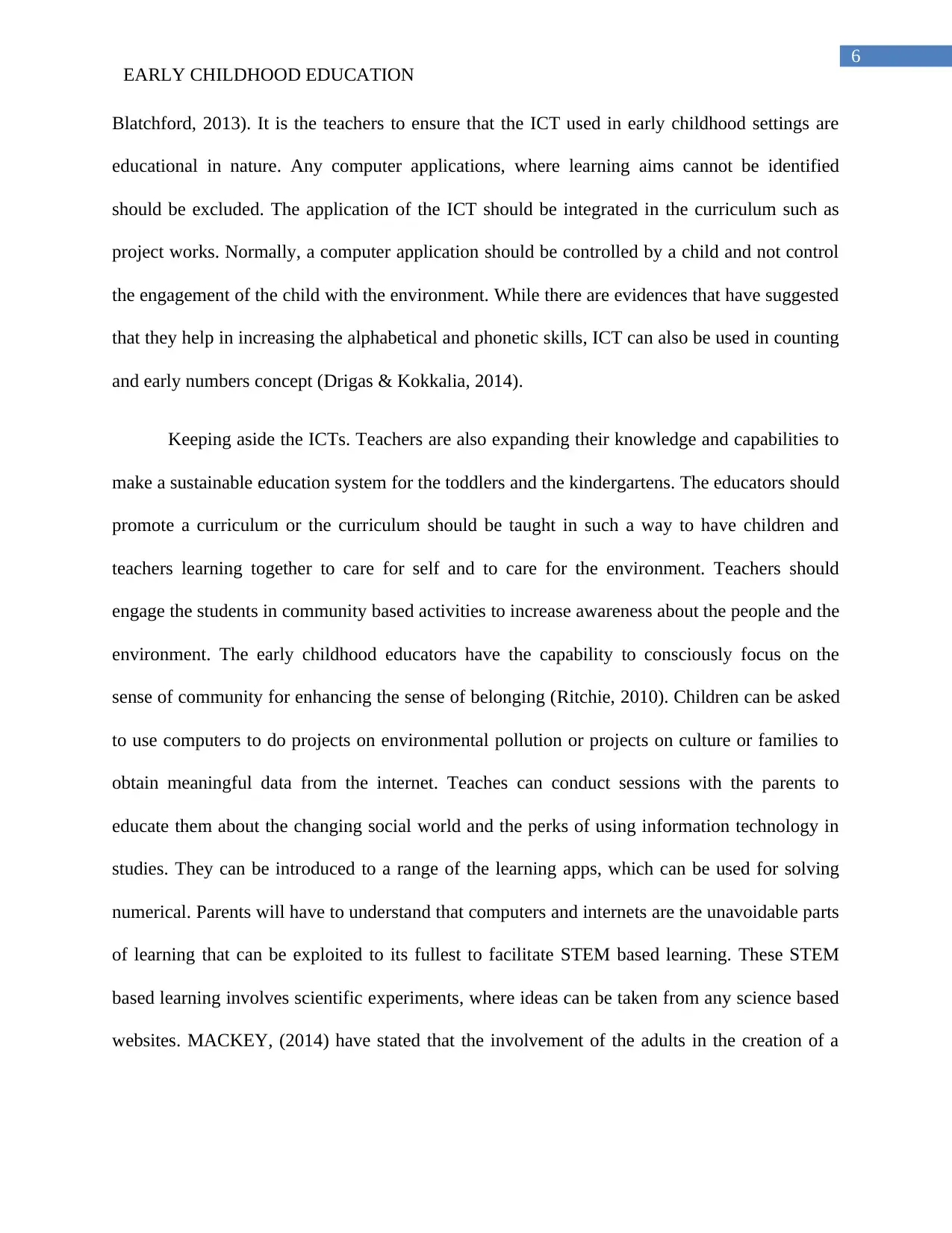
6
EARLY CHILDHOOD EDUCATION
Blatchford, 2013). It is the teachers to ensure that the ICT used in early childhood settings are
educational in nature. Any computer applications, where learning aims cannot be identified
should be excluded. The application of the ICT should be integrated in the curriculum such as
project works. Normally, a computer application should be controlled by a child and not control
the engagement of the child with the environment. While there are evidences that have suggested
that they help in increasing the alphabetical and phonetic skills, ICT can also be used in counting
and early numbers concept (Drigas & Kokkalia, 2014).
Keeping aside the ICTs. Teachers are also expanding their knowledge and capabilities to
make a sustainable education system for the toddlers and the kindergartens. The educators should
promote a curriculum or the curriculum should be taught in such a way to have children and
teachers learning together to care for self and to care for the environment. Teachers should
engage the students in community based activities to increase awareness about the people and the
environment. The early childhood educators have the capability to consciously focus on the
sense of community for enhancing the sense of belonging (Ritchie, 2010). Children can be asked
to use computers to do projects on environmental pollution or projects on culture or families to
obtain meaningful data from the internet. Teaches can conduct sessions with the parents to
educate them about the changing social world and the perks of using information technology in
studies. They can be introduced to a range of the learning apps, which can be used for solving
numerical. Parents will have to understand that computers and internets are the unavoidable parts
of learning that can be exploited to its fullest to facilitate STEM based learning. These STEM
based learning involves scientific experiments, where ideas can be taken from any science based
websites. MACKEY, (2014) have stated that the involvement of the adults in the creation of a
EARLY CHILDHOOD EDUCATION
Blatchford, 2013). It is the teachers to ensure that the ICT used in early childhood settings are
educational in nature. Any computer applications, where learning aims cannot be identified
should be excluded. The application of the ICT should be integrated in the curriculum such as
project works. Normally, a computer application should be controlled by a child and not control
the engagement of the child with the environment. While there are evidences that have suggested
that they help in increasing the alphabetical and phonetic skills, ICT can also be used in counting
and early numbers concept (Drigas & Kokkalia, 2014).
Keeping aside the ICTs. Teachers are also expanding their knowledge and capabilities to
make a sustainable education system for the toddlers and the kindergartens. The educators should
promote a curriculum or the curriculum should be taught in such a way to have children and
teachers learning together to care for self and to care for the environment. Teachers should
engage the students in community based activities to increase awareness about the people and the
environment. The early childhood educators have the capability to consciously focus on the
sense of community for enhancing the sense of belonging (Ritchie, 2010). Children can be asked
to use computers to do projects on environmental pollution or projects on culture or families to
obtain meaningful data from the internet. Teaches can conduct sessions with the parents to
educate them about the changing social world and the perks of using information technology in
studies. They can be introduced to a range of the learning apps, which can be used for solving
numerical. Parents will have to understand that computers and internets are the unavoidable parts
of learning that can be exploited to its fullest to facilitate STEM based learning. These STEM
based learning involves scientific experiments, where ideas can be taken from any science based
websites. MACKEY, (2014) have stated that the involvement of the adults in the creation of a
Paraphrase This Document
Need a fresh take? Get an instant paraphrase of this document with our AI Paraphraser
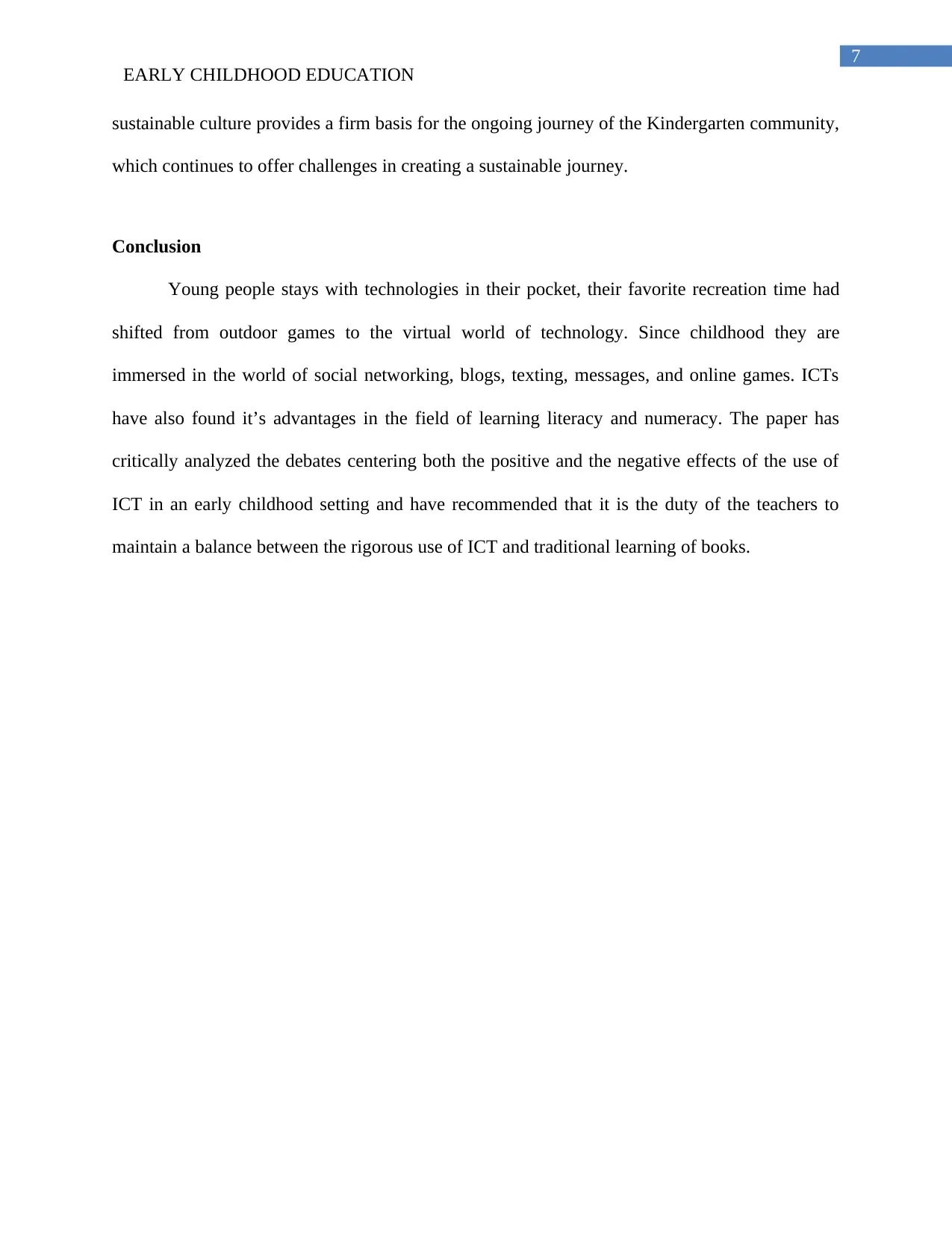
7
EARLY CHILDHOOD EDUCATION
sustainable culture provides a firm basis for the ongoing journey of the Kindergarten community,
which continues to offer challenges in creating a sustainable journey.
Conclusion
Young people stays with technologies in their pocket, their favorite recreation time had
shifted from outdoor games to the virtual world of technology. Since childhood they are
immersed in the world of social networking, blogs, texting, messages, and online games. ICTs
have also found it’s advantages in the field of learning literacy and numeracy. The paper has
critically analyzed the debates centering both the positive and the negative effects of the use of
ICT in an early childhood setting and have recommended that it is the duty of the teachers to
maintain a balance between the rigorous use of ICT and traditional learning of books.
EARLY CHILDHOOD EDUCATION
sustainable culture provides a firm basis for the ongoing journey of the Kindergarten community,
which continues to offer challenges in creating a sustainable journey.
Conclusion
Young people stays with technologies in their pocket, their favorite recreation time had
shifted from outdoor games to the virtual world of technology. Since childhood they are
immersed in the world of social networking, blogs, texting, messages, and online games. ICTs
have also found it’s advantages in the field of learning literacy and numeracy. The paper has
critically analyzed the debates centering both the positive and the negative effects of the use of
ICT in an early childhood setting and have recommended that it is the duty of the teachers to
maintain a balance between the rigorous use of ICT and traditional learning of books.
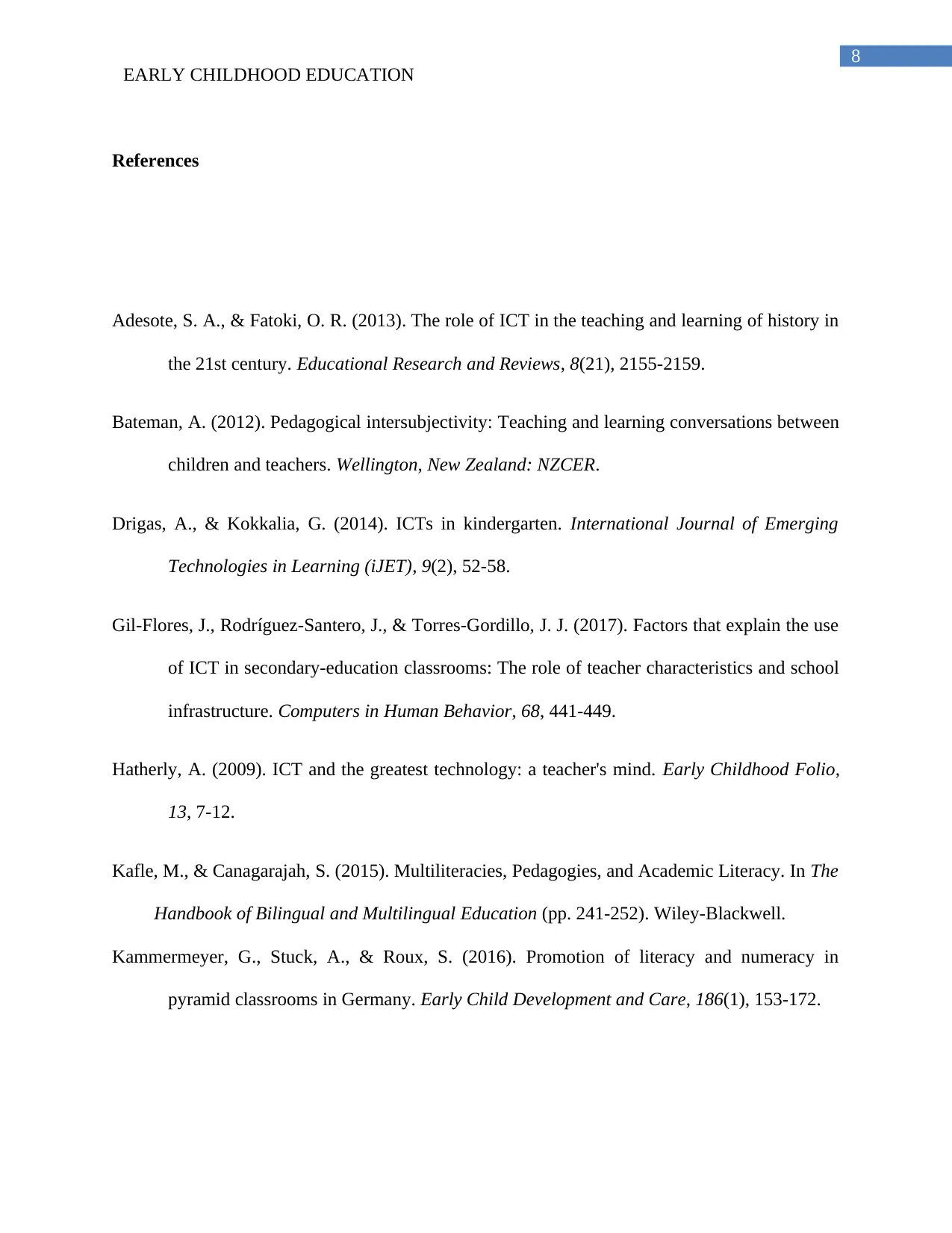
8
EARLY CHILDHOOD EDUCATION
References
Adesote, S. A., & Fatoki, O. R. (2013). The role of ICT in the teaching and learning of history in
the 21st century. Educational Research and Reviews, 8(21), 2155-2159.
Bateman, A. (2012). Pedagogical intersubjectivity: Teaching and learning conversations between
children and teachers. Wellington, New Zealand: NZCER.
Drigas, A., & Kokkalia, G. (2014). ICTs in kindergarten. International Journal of Emerging
Technologies in Learning (iJET), 9(2), 52-58.
Gil-Flores, J., Rodríguez-Santero, J., & Torres-Gordillo, J. J. (2017). Factors that explain the use
of ICT in secondary-education classrooms: The role of teacher characteristics and school
infrastructure. Computers in Human Behavior, 68, 441-449.
Hatherly, A. (2009). ICT and the greatest technology: a teacher's mind. Early Childhood Folio,
13, 7-12.
Kafle, M., & Canagarajah, S. (2015). Multiliteracies, Pedagogies, and Academic Literacy. In The
Handbook of Bilingual and Multilingual Education (pp. 241-252). Wiley-Blackwell.
Kammermeyer, G., Stuck, A., & Roux, S. (2016). Promotion of literacy and numeracy in
pyramid classrooms in Germany. Early Child Development and Care, 186(1), 153-172.
EARLY CHILDHOOD EDUCATION
References
Adesote, S. A., & Fatoki, O. R. (2013). The role of ICT in the teaching and learning of history in
the 21st century. Educational Research and Reviews, 8(21), 2155-2159.
Bateman, A. (2012). Pedagogical intersubjectivity: Teaching and learning conversations between
children and teachers. Wellington, New Zealand: NZCER.
Drigas, A., & Kokkalia, G. (2014). ICTs in kindergarten. International Journal of Emerging
Technologies in Learning (iJET), 9(2), 52-58.
Gil-Flores, J., Rodríguez-Santero, J., & Torres-Gordillo, J. J. (2017). Factors that explain the use
of ICT in secondary-education classrooms: The role of teacher characteristics and school
infrastructure. Computers in Human Behavior, 68, 441-449.
Hatherly, A. (2009). ICT and the greatest technology: a teacher's mind. Early Childhood Folio,
13, 7-12.
Kafle, M., & Canagarajah, S. (2015). Multiliteracies, Pedagogies, and Academic Literacy. In The
Handbook of Bilingual and Multilingual Education (pp. 241-252). Wiley-Blackwell.
Kammermeyer, G., Stuck, A., & Roux, S. (2016). Promotion of literacy and numeracy in
pyramid classrooms in Germany. Early Child Development and Care, 186(1), 153-172.
⊘ This is a preview!⊘
Do you want full access?
Subscribe today to unlock all pages.

Trusted by 1+ million students worldwide
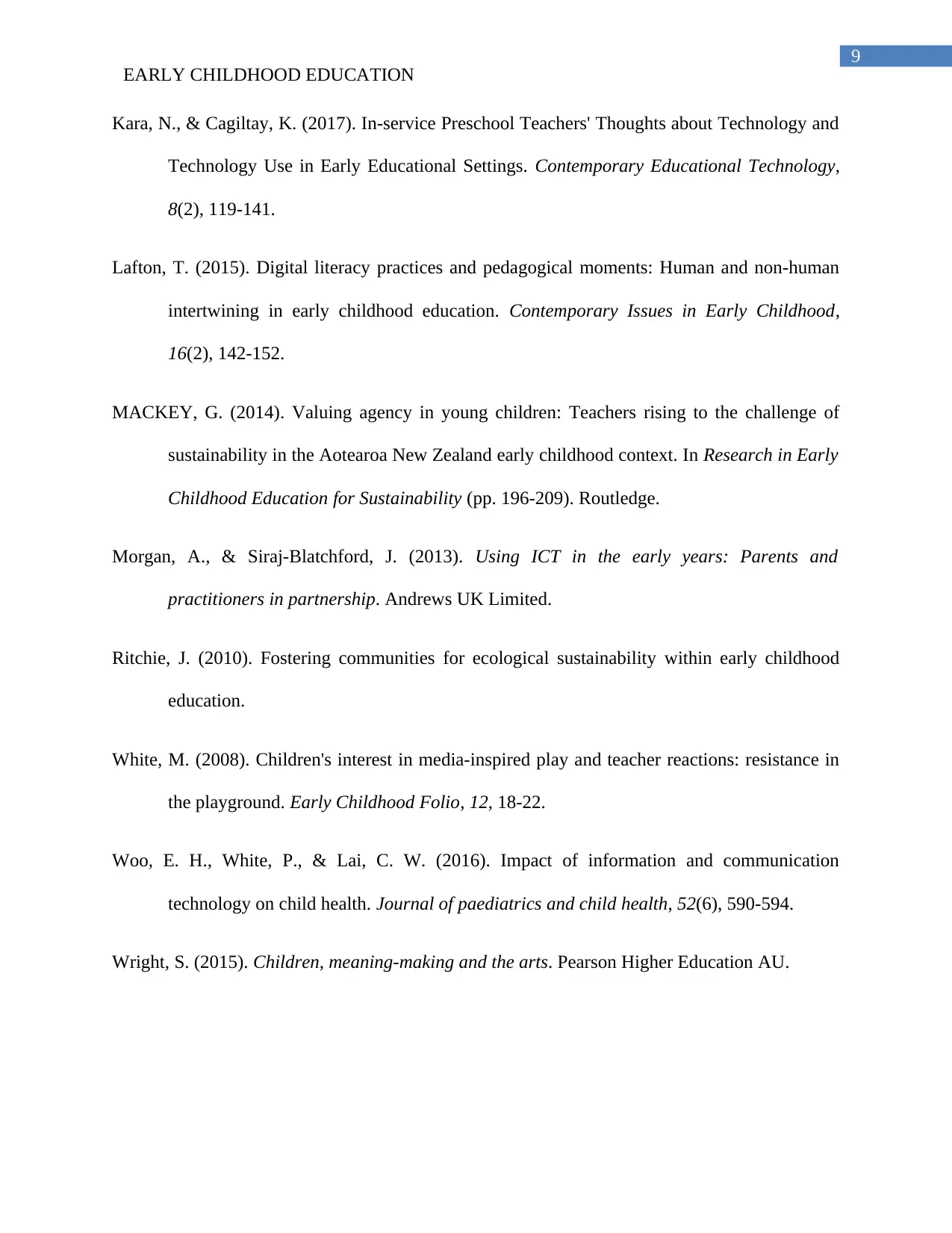
9
EARLY CHILDHOOD EDUCATION
Kara, N., & Cagiltay, K. (2017). In-service Preschool Teachers' Thoughts about Technology and
Technology Use in Early Educational Settings. Contemporary Educational Technology,
8(2), 119-141.
Lafton, T. (2015). Digital literacy practices and pedagogical moments: Human and non-human
intertwining in early childhood education. Contemporary Issues in Early Childhood,
16(2), 142-152.
MACKEY, G. (2014). Valuing agency in young children: Teachers rising to the challenge of
sustainability in the Aotearoa New Zealand early childhood context. In Research in Early
Childhood Education for Sustainability (pp. 196-209). Routledge.
Morgan, A., & Siraj-Blatchford, J. (2013). Using ICT in the early years: Parents and
practitioners in partnership. Andrews UK Limited.
Ritchie, J. (2010). Fostering communities for ecological sustainability within early childhood
education.
White, M. (2008). Children's interest in media-inspired play and teacher reactions: resistance in
the playground. Early Childhood Folio, 12, 18-22.
Woo, E. H., White, P., & Lai, C. W. (2016). Impact of information and communication
technology on child health. Journal of paediatrics and child health, 52(6), 590-594.
Wright, S. (2015). Children, meaning-making and the arts. Pearson Higher Education AU.
EARLY CHILDHOOD EDUCATION
Kara, N., & Cagiltay, K. (2017). In-service Preschool Teachers' Thoughts about Technology and
Technology Use in Early Educational Settings. Contemporary Educational Technology,
8(2), 119-141.
Lafton, T. (2015). Digital literacy practices and pedagogical moments: Human and non-human
intertwining in early childhood education. Contemporary Issues in Early Childhood,
16(2), 142-152.
MACKEY, G. (2014). Valuing agency in young children: Teachers rising to the challenge of
sustainability in the Aotearoa New Zealand early childhood context. In Research in Early
Childhood Education for Sustainability (pp. 196-209). Routledge.
Morgan, A., & Siraj-Blatchford, J. (2013). Using ICT in the early years: Parents and
practitioners in partnership. Andrews UK Limited.
Ritchie, J. (2010). Fostering communities for ecological sustainability within early childhood
education.
White, M. (2008). Children's interest in media-inspired play and teacher reactions: resistance in
the playground. Early Childhood Folio, 12, 18-22.
Woo, E. H., White, P., & Lai, C. W. (2016). Impact of information and communication
technology on child health. Journal of paediatrics and child health, 52(6), 590-594.
Wright, S. (2015). Children, meaning-making and the arts. Pearson Higher Education AU.
1 out of 10
Related Documents
Your All-in-One AI-Powered Toolkit for Academic Success.
+13062052269
info@desklib.com
Available 24*7 on WhatsApp / Email
![[object Object]](/_next/static/media/star-bottom.7253800d.svg)
Unlock your academic potential
Copyright © 2020–2025 A2Z Services. All Rights Reserved. Developed and managed by ZUCOL.





